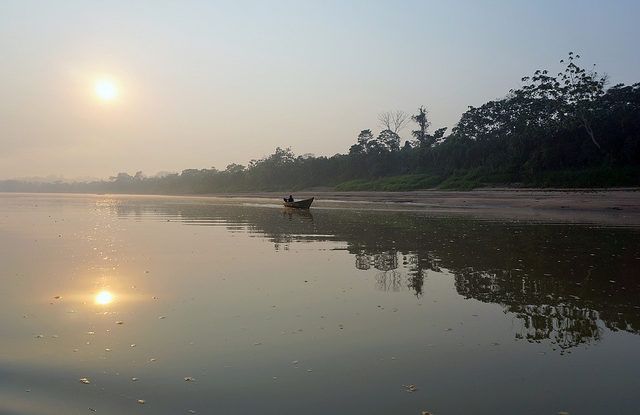BOGOR, Indonesia (Forests News) — What can 19 reviews assessing 1,200 research articles spanning over 3 billion hectares of land teach us about what works in forest governance interventions to promote sustainability?
It is widely agreed that effective governance is key to building and securing sustainability in forested areas, but the jury is still out over what that actually looks like. There are “literally scores of different governance methods that people have tried to get improved outcomes,” according to Arun Agrawal, a professor at the University of Michigan.
“We don’t have a very good sense of which interventions work well, when they work well, and why they work well,” added Agrawal, a contributing editor on a new special issue of the journal Current Opinion in Environmental Sustainability (COSUST). Each of 19 reviews in the journal aims to assess the degree of effectiveness of the environmental governance strategy they focus on, and the level of confidence information available. These interventions include, among others, REDD+ (Reducing Emissions from Deforestation and forest Degradation), protected areas, community forests, concessions, tree plantation, forests under certification, private acquisition of land for conservation, and sustainable intensification.
CRITICAL FACTORS
The issue provided an opportunity to explore commonalities among the different kinds of interventions – of which there were more than expected, Agrawal said. “Very often we think of these interventions as being quite different from each other,,but when we look at what’s associated with the success of these interventions, we find there are a common set of factors.”
As such, in the issue’s introduction, the editors identify four criteria as critical to constructing effective governance for sustainability.
Collaborative relationships between different actors and decision makers is “central,” Agrawal said. Supportive policies, adaptive management, and responsive macro-institutional frameworks are also important.
“It’s so important to look at what is going on as things are being implemented, and learn from the intervention while it’s unfolding – not coming into the process with a fixed blueprint in your mind, but being willing to adapt while you’re implementing the intervention,” he said.
As such, clear monitoring systems and performance indicators are critical. It is also key to integrate learning from different kinds of evidence, and from overlapping interventions.
“Often it was not a single intervention that by itself led to positive outcomes, but it was effective in combination with others,” he said.
What does this mean for practitioners? “It’s not that everybody should follow the same template,” Arawal cautioned. “But keeping these factors in mind when you’re trying new things could well lead to better outcomes.”
THREE ‘I’S OF ENVIRONMENTAL GOVERNANCE
The editors also identify three fundamental means for designing governance interventions related to natural resources: information, incentives, and institutions. In some interventions, actors managing or relying on forests use information to shape outcomes, assuming that with greater awareness, unsustainable behaviors may change.
For example, informing consumers about sustainably-harvested timber and zero-deforestation palm oil – and the degradation and conflict associated with their alternatives – is intended to influence buying behavior, thus increasing demand for sustainably produced commodities and prompting producer shifts towards practices and standards that align with these goals.
Another way of designing interventions is to recognize the cost of adopting more sustainable behavior, and thus provide incentives that aim to absorb this extra cost, and in so doing, enable the behaviors they are seeking to promote. This is the philosophy behind programs like REDD+ and other payments for ecosystem services (PES) approaches. Alternatively, interventions may use institutional change to impose costs and sanctions on people enacting unsustainable behaviors. For example, government agencies may enact fines or prison sentences on those caught cutting down trees in protected areas.
In reality, most forest governance interventions use a combination of all three methods, although with different amounts of emphasis on each.
In one of the review articles led by CIFOR scientist, Amy Duchelle it is clear that while REDD+ programs are centered on incentives, in practice they involve a “customized basket of integrated interventions,” which also require information-sharing and institutional change to promote behaviors that help restore degraded areas and keep forests standing.
Arawal and his colleagues hoped initially to be able to make quantitative claims about the number of hectares successfully protected through each kind of intervention. But given that each situation requires its own bespoke mix of interventions, evaluating impact at wider scales is extremely challenging. What’s more, the reviewers found that in most cases the data that exists is too “patchy” to make generic claims, Agrawal said — a serious concern given the pressing nature of the work involved.
For example, in the REDD+ review, Duchelle was “surprised by the lack of studies on the forest and land use outcomes of REDD+, as well as the rare use of counterfactual approaches to evaluate impacts of any kind.” She and her co-authors concluded that “recent research has not yet measured up to the importance of REDD+ in terms of scope, depth, and analytic sophistication,” and stressed that “as forest-rich countries refine their climate action plans post 2020, there is an urgent need for more reliable evidence on the impacts of REDD+ to date to guide their choices.”
We want you to share Forests News content, which is licensed under Creative Commons Attribution-NonCommercial-ShareAlike 4.0 International (CC BY-NC-SA 4.0). This means you are free to redistribute our material for non-commercial purposes. All we ask is that you give Forests News appropriate credit and link to the original Forests News content, indicate if changes were made, and distribute your contributions under the same Creative Commons license. You must notify Forests News if you repost, reprint or reuse our materials by contacting forestsnews@cifor-icraf.org.
